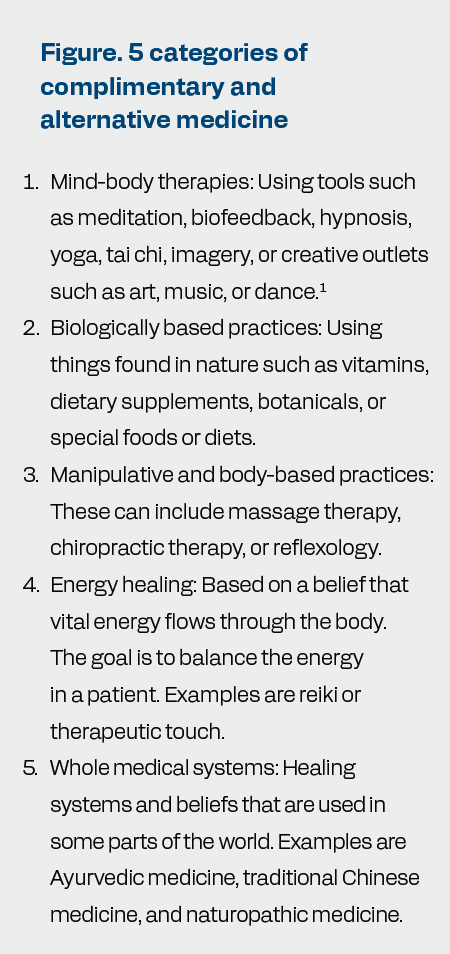Complementary and Alternative Medicine in Cancer Care: Does It Have a Role?
While treatment centered around multiple drug options is common practice in oncology, the use of complementary and medicine alternative medicine is being introduced in the space.
F
requently patients with cancer ask about alterations in their lifestyle, taking vitamins or supplements, or other treatments or practices that will improve their outcome following a cancer diagnosis. Complementary and alternative medicine (CAM) is a term for medical products and/or practices that are not part of standard medical care. However, CAM may be used as an adjunct in cancer care to overcome adverse effects of cancer treatments such as nausea, pain, or fatigue. In addition, CAM may ease the worries about cancer
treatments and related stress. Patients
often feel they are being an active participant in their cancer care when using CAM treatments.
Other common terms include integrative or complementary medicine. Both are approaches that combine conventional medicine with CAM approaches that have been shown through science and clinical trials to be safe and effective. Alternative medicine, on the other hand, is the practice of using a treatment or approach instead of standard medical treatments. Types of CAM often fit into 5 categories (Figure).1
Figure. 5 categories of complementary and alternative medicine

Some CAM therapies have undergone careful evaluation and been found to be generally safe and effective. These include acupuncture, yoga, and meditation.2 However, others either do not work or are directly harmful, so caution is important. Often CAM therapies might use botanicals or nutritional products that are not FDA approved or used in much higher doses than normal.3 These need to be monitored for safety and interactions with standard medications and anticancer treatments. A recent example from my practice was a patient taking turmeric who had liver function tests that were suddenly 5 times normal without any other explanation. Scans and multiple other labs found no reason for the elevated liver function tests, but when the turmeric was stopped, the liver functions rapidly went back to normal. Although this toxicity is rare, it did lead to additional testing, expense, and worry for this patient.
There is an important effort occurring to try to integrate proven complementary approaches to traditional cancer care. The Society for Integrative Oncology has issued evidence-based clinical practice guidelines for health care providers to consider when incorporating complementary health approaches in the care of patients with cancer. An important guideline includes not using unproven methods in place of conventional treatment for the cancer, as this may delay the scientifically-based treatment and reduce the likelihood of a remission or cure.
The bottom line is, first, do no harm. Working with the patient as a team to fight their cancer is of utmost importance. If the patient can use CAM approaches that are safe and found to be effective in clinical trials as a supportive measure, the outcome will hopefully be a positive one for the patient and the medical team. The National Institutes of Health sponsors ongoing studies to evaluate complementary approaches through the National Cancer Institute and the National Center for Complementary and Integrative Health.
References
- Gonzalez M, Pascoe MC, Yang G, et al. Yoga for depression and anxiety symptoms in people with cancer: a systemic review and meta-analysis. Psychooncology. 2021;30(8):1196-1208. doi:10.1002/pon.5671
- He Y, Guo X, May BH, et al. Clinical evidence for association of acupuncture and acupressure with improved cancer pain: a systemic review and meta-analysis. JAMA Oncology. 2020;6(2):271-278. doi:10.1001/jamaoncol.2019.5233
- US Preventive Services Task Force. Vitamin, mineral, and multivitamin supplements for the primary prevention of cardiovascular disease and cancer: preventive medication. June 21,2022. Accessed April 21, 2024. https://shorturl.at/aAFKV
